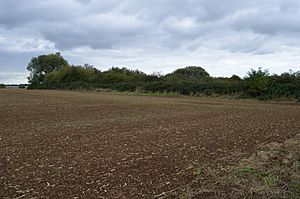Eye Gravel Pit facts for kids
| Site of Special Scientific Interest | |
 |
|
| Area of Search | Cambridgeshire |
|---|---|
| Interest | Geological |
| Area | 0.4 hectares |
| Notification | 1986 |
| Location map | Magic Map |
Hey there! Have you ever wondered about places that are super important for science? Well, Eye Gravel Pit is one of those cool spots! It's a special place in Eye Green, Cambridgeshire, England, that scientists really want to protect.
It's called a Site of Special Scientific Interest (or SSSI for short) because it helps us learn about Earth's past. This small area, about the size of half a football field (0.4 hectares), is a geological SSSI. This means it's important for studying rocks, soil, and how our planet has changed over time. It's also part of something called a Geological Conservation Review site, which highlights the best places to study geology in Britain. Part of this special site even touches the Eye Green Local Nature Reserve.
Contents
What is Eye Gravel Pit?
Eye Gravel Pit used to be a place where people dug up gravel, which is a mix of small stones and sand. This type of place is often called a quarry. But it's not just any old quarry! It's a window into what the area looked like many thousands of years ago.
A Look Back in Time: The Eemian Period
Imagine the land where Eye Gravel Pit is now. It wasn't always dry land! A very long time ago, between 130,000 and 115,000 years ago, this area was actually under the North Sea. This warm time in Earth's history is known as the Eemian period. During this period, the climate was warmer than it is today, and sea levels were higher.
Scientists have found some amazing clues in the gravel pit:
- Marine shells: These are shells from sea creatures that lived in the North Sea when it covered this area.
- Non-marine shells: These are shells from creatures that lived in freshwater or on land, showing that the area wasn't always completely under the sea.
These shells tell us a lot about the environment back then. They help scientists understand how the sea moved and how the climate changed over thousands of years.
Where Land and Ice Meet
Natural England, an organization that protects England's natural environment, says that Eye Gravel Pit is really important. Why? Because it sits right where two different types of natural deposits meet:
- Fluvial deposits: These are materials like sand and gravel that were carried and laid down by rivers.
- Glacial deposits: These are materials left behind by huge sheets of ice, called glaciers, that moved across the land during ice ages.
Finding a place where river deposits and ice deposits come together is rare and helps scientists piece together the complex story of how the landscape of East Anglia was formed. It shows how rivers flowed and how glaciers melted and shaped the land over vast periods of time.
Can You Visit Eye Gravel Pit?
Unfortunately, Eye Gravel Pit is on private land. This means it's not open to the public, so you can't visit it yourself. However, its importance for science means it's still protected and studied by experts.

